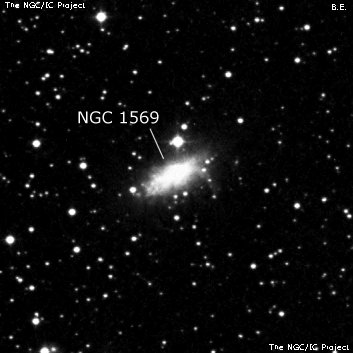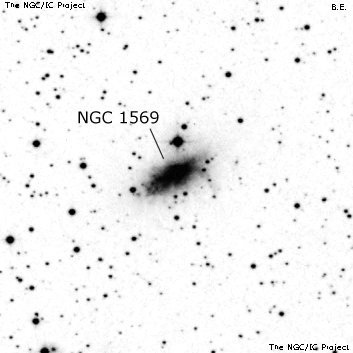NGC/IC Project Restoration Effort
(This is a very very beta version)
NGC1569


Basic Information
Location and Magnitude
Right Ascension: 4:30:49.1
Declination: +64:50:53
Constellation: CAM
Visual Magnitude: 11.0
Historic Information
Discoverer: Herschel W.
Year of discovery: 1788
Discovery aperture: 18.7
Observational
Summary description: pB, S, lE, bNM, * 9.5 n 1'
Sub-type: IBm
Steve's Notes
=====
NGC 1569
48" (10/23/11): at 488x, three very compact knots (luminous super-star clusters) are closely lined up from NW to SE in the central region (total length ~15") with the brightest knot NGC 1569-A in the middle of the trio. NGC 1569-A was flanked by 1569-C 7" NW and 1569-B 7" SE. NGC 1569-C appeared very small but was also clearly non-stellar. NGC 1569-B, very close to the geometric center, was very compact and symmetrical, like a slightly bloated star. SIMBAD lists a V mag of 15.3 for 1569-A.
18" (1/17/09): at 380x this unusual starburst galaxy appeared as a high surface brightness streak, elongated ~5:2 WNW-ESE. The brightest region is NW of center and contains two stellar or quasi-stellar knots (super-star clusters) within the glow. One of these "stars" was fairly easy (NGC 1569-A) and the other was occasionally visible. A very faint stellar object (SSC NGC 1569-B) is close to the geometric center. The ESE side of the galaxy is fairly uniform though the position angle is slightly offset. A mag 9.8 star is less than 1' N of center.
17.5" (3/1/03): at 380x this is a bright, very elongated galaxy with an unusual asymmetric appearance, situated less than 1' S of a mag 9.5 star! Extended nearly 5:2 NW-SE, 2.0'x0.8'. The bright core is offset to the NW side of the glow with a tail extending SE, possibly bending at a slight angle to the core. Two stellar "nuclei" are visible in good seeing. The brighter "star" is embedded within the core, possibly just slightly north of center. A second fainter "star" is close SE, near the edge of the core and is visible intermittently. These "stars" are actually SSC's (luminous super-star clusters). NGC 1569 was recently determined to be a member of the IC 342 galaxy group.
17.5" (1/12/02): very bright, elongated 5:2 WNW-ESE, 2.5'x1.1', high but irregular surface brightness with an asymmetric appearance. The very bright core is mottled and irregular and is offset to the NW side of the galaxy! At 380x, there are two stellar "nuclei" within this glow. The brighter stellar nucleus is fairly easy and a fainter stellar point is close SE. There is also a strong impression of a third stellar spot close west of the central nucleus. These faint "stars" are actually luminous super-star clusters, the most massive known type of star clusters (color image at http://www.lowell.edu/users/dah/papers/n1569hst.html). A mag 10 star is close off the north side, 1' from center and a mag 13 star is just off the SE end.
13.1" (1/18/85): very bright, elongated 2:1 WNW-ESE, high surface brightness, elongated bright core, mottling suspected. Located just 1' S of a mag 10 star.
8" (11/28/81): fairly bright, small, elongated. Located just south of a mag 9 star.



